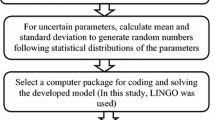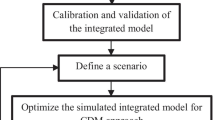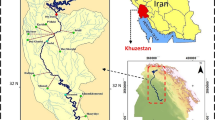Abstract
The slime mold algorithm (SMA) is applied to optimize the allocation of water resources in Wuzhi. The cost of using mathematical methods to optimize an engineered water allocation problem is enormous, and heuristic algorithms have become reliable and effective optimization tools. In this study, a multi-objective water resources optimal allocation model integrating social, economic and environmental objectives is constructed for the study area, and SMA equipped with fast convergence and accurate search is applied to optimize the problem. Water allocation schemes for the region in 2025 and 2030 were obtained, and the distribution results were independently analyzed from both the demand and supply sides. The results show that the total water distribution in 2025 and 2030 are about 323 million m\(^{3}\) and 346 million m\(^{3}\), and the water deficit ratios are 2.90% and 6.95%, respectively. From the perspective of regional development, the water dispatched in the region still is less than the water demand and the optimized water resource allocation plan can guide the development of the region.













Similar content being viewed by others
Data Availability
The datasets generated during the current study are available from the corresponding author on reasonable request.
References
Dalin C, Hanasaki N, Qiu H, Mauzerall DL, Rodriguez-Iturbe I (2014) Water resources transfers through chinese interprovincial and foreign food trade. Proc Natl Acad Sci 111(27):9774–9
UNEP: Towards a green economy : pathways to sustainable development and poverty eradication. Nairobi Kenya Unep (2017)
Mekonnen MM, Hoekstra AY (2016) Four billion people facing severe water scarcity. Sci Adv 2(2):1500323–1500323
Davijani MH, Banihabib ME, Anvar AN, Hashemi SR (2016) Multi-objective optimization model for the allocation of water resources in arid regions based on the maximization of socioeconomic efficiency. Water Resour Manage 30(3):927–946
Hadi T, Hossein JA, Ahmad MS, Hedayat F (2018) Multi-objective surface water resource management considering conflict resolution and utility function optimization. Water Resources Management: An International Journal, Published for the European Water Resources Association (EWRA) 32
Zhang L, Zhang X, Wu B, Pang Q (2020) Basin initial water rights allocation under multiple uncertainties: a trade-off analysis. Water Resources Management: An International Journal, Published for the European Water Resources Association (EWRA) 34
Roozbahani R, Abbasi B, Schreider S, Hosseinifard Z, Boros E (2020) A basin-wide approach for water allocation and dams location-allocation. Ann Oper Res 287(1):323–349
Maass A, Hufschmidt MM, Dorfman R, Thomas HA, Marglin SA, Fair GM (1962) Design of water resource system. Soil Sci 94(2):135
Haimes YY (1982) Multiobjective analysis in water resources. New York Ny American Society of Civil Engineers
Watkins DW, Mckinney DC (1995) Robust optimization for incorporating risk and uncertainty in sustainable water resources planning. iahs publications
Zhang R, Song H (2011) Optimal allocation of water resources research based on input-output method of hebei province. In: 2011 Fourth International Joint Conference on Computational Sciences and Optimization, pp. 570–573
Roozbahani R, Schreider S, Abbasi B (2013) Economic sharing of basin water resources between competing stakeholders. Water Resour Manage 27(8):2965–2988
Chen CW, Wei CC, Liu HJ, Hsu NS (2014) Application of neural networks and optimization model in conjunctive use of surface water and groundwater. Water Resour Manage 28(10):2813–2832
Rey D, Calatrava J, Garrido A (2016) Optimisation of water procurement decisions in an irrigation district: the role of option contracts. Aust J Agric Resour Econ 60(1):130–154
Daghighi A, Nahvi A, Kim U (2017) Optimal cultivation pattern to increase revenue and reduce water use: application of linear programming to arjan plain in fars province. Agric -Basel 7(9)
Li Q, Hu GP, Jubery TZ, Ganapathysubramanian B (2017) A farm-level precision land management framework based on integer programming. Plos One 12(3)
Wu J, Wang Z (2022) A hybrid model for water quality prediction based on an artificial neural network, wavelet transform, and long short-term memory. Water 14(4):610
Divakar L, Babel MS, Perret SR, Gupta AD (2013) Optimal water allocation model based on satisfaction and economic benefits. Int J Water 7(4):363–381
Zhong P, Wang H, Liu J, Chen X, Chen K (2003) Optimal dispatching model for shenzhen water resources system. J Hehai Univ (Natural Sciences )
Roozbahani R, Schreider S, Abbasi B (2015) Optimal water allocation through a multi-objective compromise between environmental, social, and economic preferences. Environ Modell Softw 64:18–30
Ren CF, Li RH, Zhang LD, Guo P (2016) Multiobjective stochastic fractional goal programming model for water resources optimal allocation among industries. J Water Resour Plann Manage 142(10)
Li M, Fu Q, Singh VP, Ma MW, Liu X (2017) An intuitionistic fuzzy multi-objective non-linear programming model for sustainable irrigation water allocation under the combination of dry and wet conditions. J Hydrol 555:80–94
Wang Y, Yang J, Chang J (2018) Development of a coupled quantity-quality-environment water allocation model applying the optimization-simulation method. J Clean Prod 213(MAR.10):944–955
Liu SS, Konstantopoulou F, Gikas P, Papageorgiou LG (2011) A mixed integer optimisation approach for integrated water resources management. Comput Chem Eng 35(5):858–875
Al-Juaidi AE, Kaluarachchi JJ, Mousa AI (2014) Hydrologic-economic model for sustainable water resources management in a coastal aquifer. J Hydrol Eng 19(11)
Joustra CM, Yeh DH (2015) Demand- and source-driven prioritization framework toward integrated building water management (ibwm). Sustain Cities Soc 14:114–125
Xi X, Poh KL (2015) A novel integrated decision support tool for sustainable water resources management in singapore: Synergies between system dynamics and analytic hierarchy process. Water Resour Manage 29(4):1329–1350
Chauhan S, Singh M, Agarwal AK (2019) Crisscross optimization algorithm for the designing of quadrature mirror filter bank. In: 2019 2nd International Conference on Intelligent Communication and Computational Techniques (Icct), 124–130
Chauhan S, Singh M, Aggarwal AK (2021) Design of a two-channel quadrature mirror filter bank through a diversity-driven multi-parent evolutionary algorithm. Circuits Syst Signal Process 40(7):3374–3394
Vashishtha G, Kumar R (2021) An effective health indicator for the pelton wheel using a levy flight mutated genetic algorithm. Meas Sci Technol 32(9):094003
Holland JH (1975) Adaptation in natural and artificial systems. ann arbor
Dorigo M, Maniezzo V (1996) Ant system: optimization by a colony of cooperating agents. IEEE Trans SMC-Part B 26(1):29
Chauhan S, Singh B, Singh M (2021) Modified ant colony optimization based PID controller design for coupled tank system. Eng Res Express 3(4):045005
Kennedy J (2011) Particle swarm optimization. In: Proc. of 1995 IEEE Int. Conf. Neural Networks, (Perth, Australia), Nov. 27-Dec. 4(8), 1942–19484
Vashishtha G, Kumar R (2022) An amended grey wolf optimization with mutation strategy to diagnose bucket defects in pelton wheel. Measurement 187
Mirjalili S (2015) Moth-flame optimization algorithm: a novel nature-inspired heuristic paradigm. Knowl-Based Syst 89:228–249
Abualigah L, Yousri D, Abd Elaziz M, Ewees A.A, Al-qaness M.A.A, Gandomi A.H (2021) Aquila optimizer: a novel meta-heuristic optimization algorithm. Comput Ind Eng 157:107250
Vashishtha G, Kumar R (2022) Autocorrelation energy and aquila optimizer for med filtering of sound signal to detect bearing defect in francis turbine. Meas Sci and Technol 33(1)
Chauhan S, Singh M, Aggarwal AK (2021) Bearing defect identification via evolutionary algorithm with adaptive wavelet mutation strategy. Measurement 179
Vashishtha G, Kumar R (2021) Centrifugal pump impeller defect identification by the improved adaptive variational mode decomposition through vibration signals. Eng Res Express 3
Beskirli A, Temurtas H, Özdemir D (2020) Determination with linear form of turkey’s energy demand forecasting by the tree seed algorithm and the modified tree seed algorithm. Adv Electric Comput Eng 20:27–34
Essa FA, Abd Elaziz M, Elsheikh AH (2020) An enhanced productivity prediction model of active solar still using artificial neural network and harris hawks optimizer. Appl Therm Eng 170:115020
Chauhan S, Singh M, Aggarwal AK (2021) Cluster head selection in heterogeneous wireless sensor network using a new evolutionary algorithm. Wireless Pers Commun 119(1):585–616
Minsker BS, Padera B, Smalley JB (2000) Efficient methods for including uncertainty and multiple objectives in water resources management models using genetic algorithms
Zhang WL, Wang C, Li Y, Wang PF, Wang Q, Wang DW (2014) Seeking sustainability: multiobjective evolutionary optimization for urban wastewater reuse in china. Environ Sci Technol 48(2):1094–1102
Chen J, Yu C, Cai M, Wang H, Zhou P (2020) Multi-objective optimal allocation of urban water resources while considering conflict resolution based on the pso algorithm: a case study of kunming, china. Sustainability 12
Adama GJ, Jimoh DO, Otache B (2020) Optimization of irrigation water allocation framework based on genetic algorithm approach. J Water Resour Prot 12(4):316–329
Cetinkaya CP, Fistikoglu O, Fedra K, Harmancioglu NB (2008) Optimization methods applied for sustainable management of water-scarce basins. J Hydroinf 10(1):69–95
Li Y, Ye QL, Liu A, Meng FG, Zhang WL, Xiong W, Wang PF, Wang C (2017) Seeking urbanization security and sustainability: Multi-objective optimization of rainwater harvesting systems in china. J Hydrol 550:42–53
Qi SQ, Wan LH, Fu BL (2020) Multisource and multiuser water resources allocation based on genetic algorithm. J Supercomput 76(5):3222–3230
Li JY, Cui LB, Dou M, Ali A (2021) Water resources allocation model based on ecological priority in the arid region. Environ Res 199
Wu X, Wang Z, Wu T, Bao X (2021) Solving the family traveling salesperson problem in the adleman-lipton model based on dna computing. IEEE Trans Nanobiosci 21(1):75–85
Wang Z, Bao X, Wu T (2021) A parallel bioinspired algorithm for chinese postman problem based on molecular computing. Comput Intell Neurosci 2021
Li S, Chen H, Wang M, Heidari AA, Mirjalili S (2020) Slime mould algorithm: A new method for stochastic optimization. Futur Gener Comput Syst 111:300–323
Zubaidi SL, Abdulkareem IH, Hashim KS, Al-Bugharbee H, Ridha HM, Gharghan SK, Al-Qaim FF, Muradov M, Kot P, Al-Khaddar R (2020) Hybridised artificial neural network model with slime mould algorithm: a novel methodology for prediction of urban stochastic water demand. Water 12(10)
Vashishtha G, Chauhan S, Singh M, Kumar R (2021) Bearing defect identification by swarm decomposition considering permutation entropy measure and opposition-based slime mould algorithm. Measurement 178
Chauhan S, Vashishtha G, Kumar A (2022) A symbiosis of arithmetic optimizer with slime mould algorithm for improving global optimization and conventional design problem. J Supercomput 78(5):6234–6274
Digalakis J, Margaritis KG (2001) On benchmarking functions for genetic algorithm. Int J Comput Math 777
Molga M, Smutnicki C (2005) Test functions for optimization needs. http://zsd.ict.pwr.wroc.pl/
Yang X-S (2010) Test problems in optimization
Tian L, D, Y (2021) Optimal allocation of regional water resources based on whale optimization algorithm. China Rural Water and Hydropower, 31–3442
Allan JA (1998) Virtual water: a strategic resource global solutions to regional deficits. Ground Water 36(4):545–546
Ye QL, Li Y, Zhuo L, Zhang WL, Xiong W, Wang C, Wang PF (2018) Optimal allocation of physical water resources integrated with virtual water trade in water scarce regions: A case study for beijing, china. Water Res 129:264–276
Acknowledgements
It was supported by the Open Research Fund of State Key Laboratory of Simulation and Regulation of Water Cycle in River Basin, China Institute of Water Resources and Hydropower Research (grant No. IWHR-SKL-201905).
Author information
Authors and Affiliations
Corresponding author
Ethics declarations
Disclosures
The authors declare that there is no conflict of interest.
Additional information
Publisher's Note
Springer Nature remains neutral with regard to jurisdictional claims in published maps and institutional affiliations.
Rights and permissions
About this article
Cite this article
Wu, X., Wang, Z. Multi-objective optimal allocation of regional water resources based on slime mould algorithm. J Supercomput 78, 18288–18317 (2022). https://doi.org/10.1007/s11227-022-04599-w
Accepted:
Published:
Issue Date:
DOI: https://doi.org/10.1007/s11227-022-04599-w




